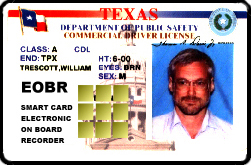SIMPLIFIED
HOURS OF SERVICE RULES
as proposed by
William B. Trescott
 1) Commercial motor vehicle operators MUST cease all work
for 10 uninterrupted hours after each 14 hours on duty.
1) Commercial motor vehicle operators MUST cease all work
for 10 uninterrupted hours after each 14 hours on duty.
2) Commercial motor vehicle operators
MUST rest a total of one hour during each 7
hours on duty.
3) Commercial motor vehicle operators
may not be dispatched to drive more than 10 hours in a 24 hour period
or be on duty more than 70 hours in any time period unless an equivalent
number of hours are logged off duty.
4) No more than six consecutive hours of driving or other labor may
be performed without an on duty rest period and no more than 12 hours of
driving and/or other labor may be performed within any 24 hour period.
5) Drivers may inspect and count freight, monitor gauges, inspect
their vehicles for safety defects, complete paperwork, wait for
dispatch, wait for loading or unloading, or wait for repairs during
on duty rest periods.
6) Drivers MAY NOT drive, operate material handling equipment, touch
or wrap freight, connect hoses, or perform any labor that would
prevent eating or sleeping during on duty rest periods. Any
task requiring the use of both hands MAY NOT be performed during on
duty rest periods.
ELECTRONIC ON BOARD RECORDERS
7) Smart card EOBR's will be issued by each of the 50 States with
a new Commercial Drivers License (CDL) permanently laminated to the front
with a tamper evident seal.
8) Commercial vehicles will be equipped with an inexpensive magnetic
SENSOR capable of recording and transmitting vehicle speed to nearby EOBR's
in the same manner as a wireless bicycle cyclometer.
9) ALL movements of the vehicle exceeding 5 minutes and 5 mph will
automatically be recorded as ON DUTY.
10) Whenever a vehicle is stationary longer than five minutes, EOBR's
will automatically record REST periods and log drivers OFF DUTY from the
time of the last vehicle movement 14 hours after the first vehicle movement.
11) Vehicles must remain stationary during REST periods unless a
second EOBR is logged ON DUTY (When riding in the sleeper, off duty drivers
must carry their EOBR's in a metal sleeve).
12) SENSORS will download and store data from EOBR's to detect violations
when a driver operates more than one vehicle.
13) When violations are detected, SENSORS will wirelessly transmit
a silent alarm to law enforcement officers and record the alarm on the
EOBR to prevent violators from changing vehicles.
14) SENSORS WILL NOT transmit personal information about drivers'
activities or whereabouts unless a violation is detected. If ordered
by a court of law, EOBR data can be downloaded by law enforcement officials
using a smart card reader. A SENSOR not detecting a violation
will transmit only the vehicle speed and an identification code to indicate
that an EOBR is present and operating properly. Driving without
a working EOBR will result in a silent alarm.
15) An EOBR REPEATER may be purchased from major truck stop chains
that will display driving and on duty time remaining to warn the driver
before the EOBR records a violation. REPEATERS may also be purchased
by law enforcement agencies and any concerned citizen to detect silent
alarms and report violations.
16) EOBR's will be reprogrammed with a unique status code which
will be changed every few weeks and with every violation to prevent the
manufacture of bogus EOBR's or hacking into the FMCSA's computer system
to alter records or obtain personal information.
A 2004 court order questioned
the Federal Motor Carrier Safety Administration's decision to increase
consecutive hours of driving time from 10 to 11 hours per day. The
above rules limit consecutive hours of driving to 6 with 12 hours as
an ABSOLUTE DAILY LIMIT which CANNOT BE EXCEEDED for any reason as in the
pre 2003 rules. Because such activities as loading, unloading,
fueling, and parking will be recorded as driving time whereas in the past
these activities were logged as "on duty not driving," drivers using the
above rules cannot be dispatched to drive more than 10 hours per day
if the 12 hour limit is not to be exceeded. However, allowing drivers
paid by the mile to drive more than 70 hours per week could lead to employer
abuse, therefore consistent with the court's opinion, drivers will be
returned home before 70 hours of labor in excess of off duty time is accumulated
while retaining the flexibility to occasionally work overtime to ensure
that all time off other than eating and sleeping is spent at home unless
a paid vacation is provided.
HOME
,
1000 CHURCHES
,
BUS 2000
,
FAQS
,
HOURS OF SERVICE PROPOSAL
,
SAFETY MALL,
OWNER'S
MANUAL,
SAFE TRUCK
SAFER TRUCK BILL,
NEW BILL,
MILITARY
APPLICATIONS,
INFORMATION
,
SAFETY TRUCK
,
SAILING VIDEOS
,
TRUCKER'S BILL OF RIGHTS
 1) Commercial motor vehicle operators MUST cease all work
for 10 uninterrupted hours after each 14 hours on duty.
1) Commercial motor vehicle operators MUST cease all work
for 10 uninterrupted hours after each 14 hours on duty.